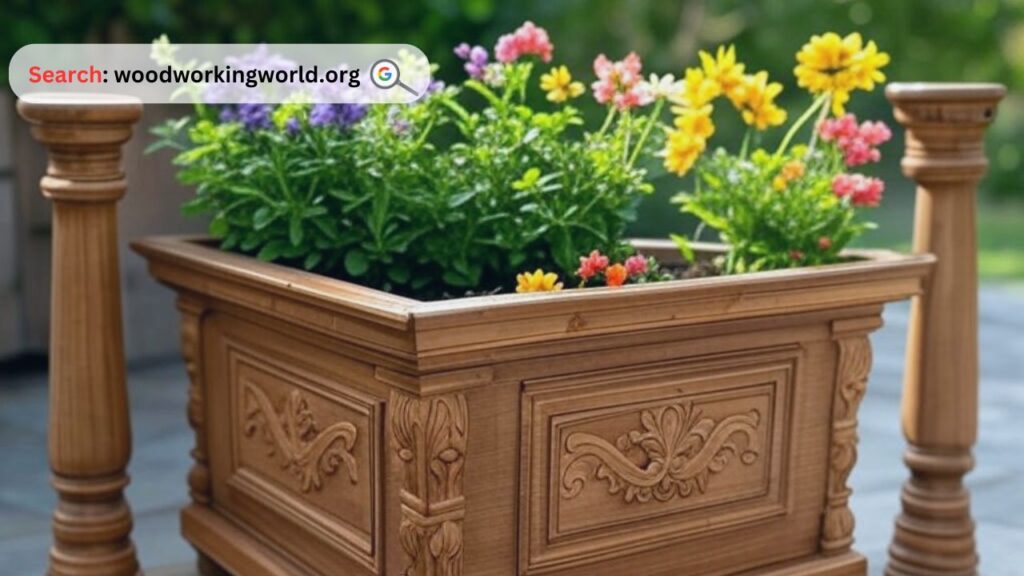Add charm to your space with a beautiful square wooden planter box! Perfect for gardens, patios, and balconies, it enhances any setting with natural elegance.
A square wooden planter box is a versatile and stylish addition to any garden, balcony, or indoor space. Whether you want to grow flowers, vegetables, or herbs, a well-crafted wooden planter provides both functionality and aesthetic appeal. With the right choice of wood, finish, and design, these planters can transform your space into a green sanctuary.

In this guide, we will explore the benefits of using a square wooden planter box, provide a step-by-step process for building one, compare different types of wood, and answer common questions to help you make the best choice for your gardening needs.
Benefits of a Square Wooden Planter Box
- Aesthetic Appeal: The natural look of wood adds warmth and character to any setting.
- Durability: With proper maintenance, wooden planters can last for years.
- Customization: Easily painted, stained, or designed to match your decor.
- Eco-Friendly: Wood is a sustainable material, especially when sourced responsibly.
- Better Drainage: Unlike plastic planters, wooden boxes allow for better airflow and drainage, promoting healthier plant growth.
Build 16,000+ Projects with Step-by-Step Plans—No Big Workshop or Costly Tools Needed! Start Now!
Step-by-Step Guide to Building a Square Wooden Planter Box
Materials Required
- Wood Planks (Cedar, Redwood, or Pine)
- Saw (Hand saw or circular saw)
- Screws or Nails
- Drill and Drill Bits
- Measuring Tape and Pencil
- Wood Glue
- Sandpaper
- Wood Stain or Paint (Optional)
- Waterproof Liner (Optional)
Step 1: Choose the Right Wood
Selecting the right type of wood is crucial. Cedar and redwood are naturally resistant to rot and insects, making them excellent choices for outdoor planters. Pine is a budget-friendly option but requires a protective sealant to withstand moisture.
Step 2: Measure and Cut the Wood
Using a measuring tape, mark the dimensions of the planter box. A common size is 12×12 inches or 16×16 inches, but you can adjust according to your needs. Cut four equal-sized planks for the sides and a square base panel.
Step 3: Sand and Prepare the Wood
Smooth the edges and surfaces with sandpaper to remove splinters. This step ensures a polished look and prevents injuries while handling the planter.
Step 4: Assemble the Box
- Attach the sides together using wood glue and screws for a sturdy frame.
- Secure the bottom panel to the frame using nails or screws.
- Reinforce the corners with extra screws for added durability.
Step 5: Add Drainage Holes
Drill small holes in the base of the planter to allow excess water to drain, preventing root rot.
Step 6: Apply Finishing Touches
To enhance the longevity of your planter, apply a wood stain or outdoor sealant. This protects the wood from moisture and sun damage.
Step 7: Line the Interior (Optional)
If you want additional protection against moisture, line the interior with a waterproof liner or plastic sheet.
Step 8: Fill and Plant
Add a layer of gravel at the bottom for better drainage, followed by nutrient-rich potting soil. Plant your chosen flowers, herbs, or vegetables and water them appropriately.
Expert tips on Woodworking 🌿📦 Watch now! 🎥

Comparison of Wood Types for Planter Boxes
| Wood Type | Durability | Cost | Resistance to Rot | Best Use |
|---|---|---|---|---|
| Cedar | High | $$ | Excellent | Outdoor, long-term use |
| Redwood | High | $$$ | Excellent | Outdoor, premium choice |
| Pine | Medium | $ | Requires sealing | Budget-friendly option |
| Teak | Very High | $$$$ | Excellent | Luxury, durable option |
| Oak | High | $$$ | Good with treatment | Indoor and outdoor use |
Quote for Inspiration
“Gardening is the purest of human pleasures.” – Francis Bacon
FAQs
1. How long does a wooden planter box last?
With proper care and sealing, a wooden planter box can last 5-10 years or more, depending on the wood type and environmental conditions.
2. Do I need to treat the wood before using it?
Yes, untreated wood should be stained or sealed to protect it from moisture and insects.
3. Can I use reclaimed wood for my planter?
Absolutely! Reclaimed wood is an eco-friendly choice but should be sanded and treated to remove any contaminants.
4. How do I prevent my wooden planter from rotting?
Use rot-resistant wood like cedar, apply a waterproof sealant, and ensure proper drainage to minimize moisture retention.
5. What plants grow best in a wooden planter?
Herbs like basil and mint, flowers like petunias and marigolds, and vegetables like lettuce and tomatoes thrive in wooden planters.

Conclusion
A square wooden planter box is a charming and functional addition to any space. Whether you choose to build one yourself or purchase a pre-made option, the benefits of wooden planters make them a worthwhile investment. With proper care, they provide a beautiful home for your plants and enhance the aesthetic of your surroundings. Happy planting!
Click To Order Teds Woodworking With A 60-Money-back Guarantee From – Official Website